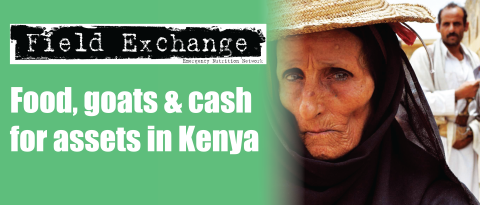Feasibility and effectiveness of preventing child malnutrition with local foods in Kenya
Summary of research1

One of the researchers (Rebecca Ashton) weighs a child
The findings of a study to establish the operational feasibility and effectiveness of using locally available foods to prevent malnutrition and improve child growth in Kenyan children have recently been published. The study took place in rural villages in the arid lands of eastern Kenya, which have a high prevalence of child malnutrition as identified by a survey conducted in March 2009. The study sites were in Yatta District of Eastern Province, Kenya.
The diet in the area is maize-based and children are commonly fed a porridge made from maize flour with a low energy density so that the growth of young children falters as early as 3-4 months of age. Animal-source foods are rarely fed to children. One of the reasons for carrying out the study was recognition that aid programmes using commercially prepared products are not sustainable and that distribution of local foods combined with an education programme could potentially lead to improved local production and result in better complementary feeding.
The study employed a quasi-experimental design with an intervention group of children in all villages in one region and a non-intervention group of children in all villages in an adjacent region. Both sub-locations are governed by the same local chief and have community health workers who participate in the screening of the households with children under five years of age for acute malnutrition. All children who lived in the two sub-locations were eligible to participate if they were 6-20 months of age at the onset of the study and had a weight-for-height z score (WHZ) =-2. Children with WHZ <-2 were enrolled into a community-based therapeutic feeding programme and were excluded from the study. The intervention was the distribution of a monthly food ration for the index child, a separate family ration, and group education on appropriate complementary feeding and hygiene.
Children in the intervention and nonintervention groups had similar baseline anthropometric measures. The caregivers in the intervention group confirmed that the intended amounts of food supplements were received and child nutrient intake improved. During the 7-month intervention period there were significant group differences in pre-post z-score changes between the intervention and non-intervention groups for weight-for-age (0.82, P<0.001) and WHZ (1.19, P<0.001), but not for height-for-age (0% v. 8.9%, P = 0.0002) and underweight (6.3% v. 23.0%, P <0.0001). Infectious morbidity was similar in both groups.
The likely explanation for the substantial decline in height-for-age Z-score in the intervention group as well as the non-intervention group was that the intervention period was too short to have an impact. A contributing factor may have been the age of the children when the intervention started. Although the study was planned with the intent to intervene as early as possible after complementary foods are introduced, the mean age at study entry was 14 months in the intervention group and the prevalence of growth stunting was already 27%. As anticipated, food was being shared with other family members, mostly other children.
However, intra-household sharing of food was taken into consideration in the intervention design which allowed for an extra 920 Kj/d per study child. Therefore, despite the leakage of the supplements, the index child received a sufficient amount of the food to significantly improve the nutrient intake and prevent the development of wasting.
The findings suggest that the distribution of locally available foods combined with brief group nutrition education sessions is operationally feasible and improves child weight gain and decreases acute malnutrition in Kenyan children. However, it remains to be seen whether such an approach has greater potential for sustainability through increasing production and availability of local foods in the longer-term.
1Tomedi.A (2012). Feasibility and effectiveness of supplementation with locally available foods in prevention of child malnutrition in Kenya. Public Health Nutrition: 15 (4), pp 749-756
Imported from FEX website


